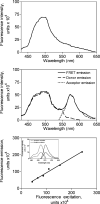Use of multidimensional fluorescence resonance energy transfer to establish the orientation of cholecystokinin docked at the type A cholecystokinin receptor
- PMID: 18700727
- PMCID: PMC3648886
- DOI: 10.1021/bi800734w
Use of multidimensional fluorescence resonance energy transfer to establish the orientation of cholecystokinin docked at the type A cholecystokinin receptor
Abstract
Fluorescence resonance energy transfer (FRET) represents a powerful tool to establish relative distances between donor and acceptor fluorophores. By utilizing several donors situated in distinct positions within a docked full agonist ligand and several acceptors distributed at distinct sites within its receptor, multiple interdependent dimensions can be determined. These can provide a unique method to establish or confirm three-dimensional structure of the molecular complex. In this work, we have utilized full agonist analogues of cholecystokinin (CCK) with Aladan distributed throughout the pharmacophore in positions 24, 29, and 33, along with receptor constructs derivatized with Alexa (546) at positions 94, 102, 204, and 341 in the helical bundle and first, second, and third extracellular loops, respectively. These provided 12 FRET distances to overlay on working models of the CCK-occupied receptor. These established that the carboxyl terminus of CCK resides at the external surface of the lipid bilayer, adjacent to the receptor amino-terminal tail, rather than being inserted into the helical bundle. They also provide important experimentally derived constraints for understanding spatial relationships between the docked ligand and the flexible extracellular loop regions. Multidimensional FRET provides a new independent method to establish and refine structural insights into ligand-receptor complexes.
Figures



Similar articles
-
Measurement of intermolecular distances for the natural agonist Peptide docked at the cholecystokinin receptor expressed in situ using fluorescence resonance energy transfer.Mol Pharmacol. 2004 Jan;65(1):28-35. doi: 10.1124/mol.65.1.28. Mol Pharmacol. 2004. PMID: 14722234
-
Fluorescence resonance energy transfer analysis of the antagonist- and partial agonist-occupied states of the cholecystokinin receptor.J Biol Chem. 2005 May 13;280(19):18631-5. doi: 10.1074/jbc.M410834200. Epub 2005 Mar 9. J Biol Chem. 2005. PMID: 15757907
-
Fluorescent indicators distributed throughout the pharmacophore of cholecystokinin provide insights into distinct modes of binding and activation of type A and B cholecystokinin receptors.J Biol Chem. 2006 Sep 15;281(37):27072-80. doi: 10.1074/jbc.M605098200. Epub 2006 Jul 20. J Biol Chem. 2006. PMID: 16857665
-
Therapeutic potential for novel drugs targeting the type 1 cholecystokinin receptor.Br J Pharmacol. 2010 Mar;159(5):1009-21. doi: 10.1111/j.1476-5381.2009.00489.x. Epub 2009 Nov 18. Br J Pharmacol. 2010. PMID: 19922535 Free PMC article. Review.
-
Structure of cholecystokinin receptor binding sites and mechanism of activation/inactivation by agonists/antagonists.Pharmacol Toxicol. 2002 Dec;91(6):313-20. doi: 10.1034/j.1600-0773.2002.910608.x. Pharmacol Toxicol. 2002. PMID: 12688374 Review.
Cited by
-
Cholecystokinin-induced satiety, a key gut servomechanism that is affected by the membrane microenvironment of this receptor.Int J Obes Suppl. 2016 Dec;6(Suppl 1):S22-S27. doi: 10.1038/ijosup.2016.5. Epub 2016 Nov 16. Int J Obes Suppl. 2016. PMID: 28685026 Free PMC article. Review.
-
Fluorescent approaches for understanding interactions of ligands with G protein coupled receptors.Biochim Biophys Acta. 2014 Jan;1838(1 Pt A):15-33. doi: 10.1016/j.bbamem.2013.09.005. Epub 2013 Sep 18. Biochim Biophys Acta. 2014. PMID: 24055822 Free PMC article. Review.
-
Molecular Mechanism of Action of Triazolobenzodiazepinone Agonists of the Type 1 Cholecystokinin Receptor. Possible Cooperativity across the Receptor Homodimeric Complex.J Med Chem. 2015 Dec 24;58(24):9562-77. doi: 10.1021/acs.jmedchem.5b01110. Epub 2015 Dec 10. J Med Chem. 2015. PMID: 26654202 Free PMC article.
-
Regulation of acinar cell function in the pancreas.Curr Opin Gastroenterol. 2010 Sep;26(5):478-83. doi: 10.1097/MOG.0b013e32833d11c6. Curr Opin Gastroenterol. 2010. PMID: 20625287 Free PMC article. Review.
-
Elucidation of the molecular basis of cholecystokinin Peptide docking to its receptor using site-specific intrinsic photoaffinity labeling and molecular modeling.Biochemistry. 2009 Jun 16;48(23):5303-12. doi: 10.1021/bi9004705. Biochemistry. 2009. PMID: 19441839 Free PMC article.
References
-
- Palczewski K, Kumasaka T, Hori T, Behnke CA, Motoshima H, Fox BA, Le Trong I, Teller DC, Okada T, Stenkamp RE, Yamamoto M, Miyano M. Crystal structure of rhodopsin: A G protein-coupled receptor. Science. 2000;289:739–745. - PubMed
-
- Rosenbaum DM, Cherezov V, Hanson MA, Rasmussen SG, Thian FS, Kobilka TS, Choi HJ, Yao XJ, Weis WI, Stevens RC, Kobilka BK. GPCR engineering yields high-resolution structural insights into beta2-adrenergic receptor function. Science. 2007;318:1266–1273. - PubMed
-
- Ji TH, Grossmann M, Ji I. G protein-coupled receptors. I. Diversity of receptor-ligand interactions. J. Biol. Chem. 1998;273:17299–17302. - PubMed
Publication types
MeSH terms
Substances
Grants and funding
LinkOut - more resources
Full Text Sources

